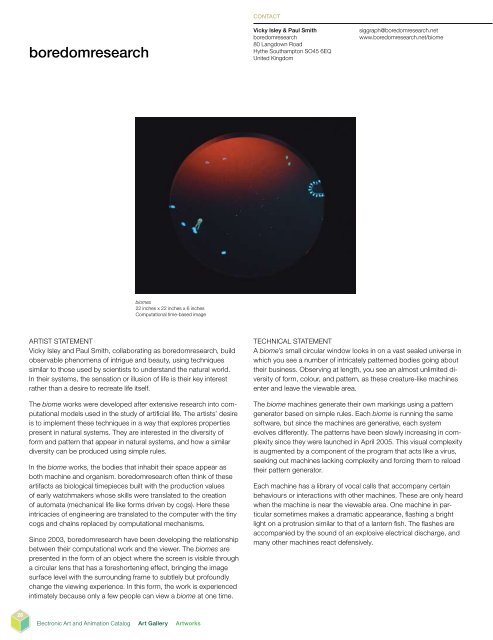Intersections - Nguyen Dang Binh
Intersections - Nguyen Dang Binh
Intersections - Nguyen Dang Binh
You also want an ePaper? Increase the reach of your titles
YUMPU automatically turns print PDFs into web optimized ePapers that Google loves.
oredomresearch<br />
biomes<br />
22 inches x 22 inches x 6 inches<br />
Computational time-based image<br />
ARTIST STATEMENT<br />
Vicky Isley and Paul Smith, collaborating as boredomresearch, build<br />
observable phenomena of intrigue and beauty, using techniques<br />
similar to those used by scientists to understand the natural world.<br />
In their systems, the sensation or illusion of life is their key interest<br />
rather than a desire to recreate life itself.<br />
The biome works were developed after extensive research into computational<br />
models used in the study of artificial life. The artists’ desire<br />
is to implement these techniques in a way that explores properties<br />
present in natural systems. They are interested in the diversity of<br />
form and pattern that appear in natural systems, and how a similar<br />
diversity can be produced using simple rules.<br />
In the biome works, the bodies that inhabit their space appear as<br />
both machine and organism. boredomresearch often think of these<br />
artifacts as biological timepieces built with the production values<br />
of early watchmakers whose skills were translated to the creation<br />
of automata (mechanical life like forms driven by cogs). Here these<br />
intricacies of engineering are translated to the computer with the tiny<br />
cogs and chains replaced by computational mechanisms.<br />
Since 2003, boredomresearch have been developing the relationship<br />
between their computational work and the viewer. The biomes are<br />
presented in the form of an object where the screen is visible through<br />
a circular lens that has a foreshortening effect, bringing the image<br />
surface level with the surrounding frame to subtlely but profoundly<br />
change the viewing experience. In this form, the work is experienced<br />
intimately because only a few people can view a biome at one time.<br />
Electronic Art and Animation Catalog Art Gallery Artworks<br />
CONTACT<br />
Vicky Isley & Paul Smith<br />
boredomresearch<br />
80 langdown Road<br />
Hythe Southampton SO45 6EQ<br />
United Kingdom<br />
siggraph@boredomresearch.net<br />
www.boredomresearch.net/biome<br />
TECHNICAl STATEMENT<br />
A biome’s small circular window looks in on a vast sealed universe in<br />
which you see a number of intricately patterned bodies going about<br />
their business. Observing at length, you see an almost unlimited diversity<br />
of form, colour, and pattern, as these creature-like machines<br />
enter and leave the viewable area.<br />
The biome machines generate their own markings using a pattern<br />
generator based on simple rules. Each biome is running the same<br />
software, but since the machines are generative, each system<br />
evolves differently. The patterns have been slowly increasing in complexity<br />
since they were launched in April 2005. This visual complexity<br />
is augmented by a component of the program that acts like a virus,<br />
seeking out machines lacking complexity and forcing them to reload<br />
their pattern generator.<br />
Each machine has a library of vocal calls that accompany certain<br />
behaviours or interactions with other machines. These are only heard<br />
when the machine is near the viewable area. One machine in particular<br />
sometimes makes a dramatic appearance, flashing a bright<br />
light on a protrusion similar to that of a lantern fish. The flashes are<br />
accompanied by the sound of an explosive electrical discharge, and<br />
many other machines react defensively.

















